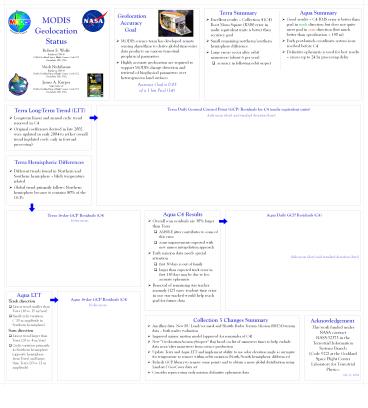MODIS
1 / 1
Title:
MODIS
Description:
Terra Daily Ground Control Point (GCP) Residuals for C4 (nadir equivalent units) ... Improved mirror motion model (approved for remainder of C4) ... –
Number of Views:88
Avg rating:3.0/5.0
Title: MODIS
1
Aqua Summary
Terra Summary
MODIS Geolocation Status
- Geolocation
- Accuracy
- Goal
- MODIS science team has developed remote sensing
algorithms to derive global time-series data
products on various terrestrial geophysical
parameters - Highly accurate geolocation are required to
support MODIS change detection and retrieval of
biophysical parameters over heterogeneous land
surfaces - Accuracy Goal is 0.05
- of a 1 km Pixel (1s)
- Good results C4 RMS error is better than goal
in track direction but does not quite meet goal
in scan direction (but much better than
specification 150 m) - Early post-launch coordinate system issue
resolved before C4 - Definitive ephemeris is used for best results
causes up to 24 hr processing delay
- Excellent results Collection 4 (C4) Root Mean
Square (RMS) error in nadir equivalent units is
better than accuracy goal - Small remaining northern/southern hemisphere
difference - Large errors occur after orbit maneuvers (about 6
per year) - accuracy in following orbit suspect
Robert E. Wolfe Raytheon ITSS _at_ NASA Goddard
Space Flight Center, Code 922Greenbelt, MD, USA
Mash Nishihama Raytheon ITSS _at_NASA Goddard Space
Flight Center, Code 922, Greenbelt, MD, USA
James A. Kuyper SAIC/GSC _at_NASA Goddard Space
Flight Center, Code 922, Greenbelt, MD, USA
Terra Daily Ground Control Point (GCP) Residuals
for C4 (nadir equivalent units)
Terra Long-Term Trend (LTT)
daily mean (dots) and standard deviation (bars)
- Long-term linear and annual cyclic trend removed
in C4 - Original coefficients derived in late 2002 were
updated in early 2004 to reflect overall trend
(updated coefs. only in forward processing)
Terra Hemispheric Differences
- Different trends found in Northern and Southern
hemisphere likely temperature related - Global trend primarily follows Northern
hemisphere because it contains 80 of the GCPs
Aqua C4 Results
Aqua Daily GCP Residuals (C4)
Terra 16-day GCP Residuals (C4)
16-day mean
- Overall scan residuals are 30 larger than Terra
- AMSR-E jitter contributes to some of this error
- some improvements expected with new mirror
interpolation approach - Early mission data needs special attention
- first 30 days is out of family
- larger than expected track error in first 150
days may be due to less accurate ephemeris - Removal of remaining star tracker anomaly (125
msec readout time error in one star tracker)
would help reach goal for future data
daily mean (dots) and standard deviation (bars)
Aqua LTT
Aqua 16-day GCP Residuals (C4)
- Track direction
- Linear trend smaller than Terra (10 vs. 15
m/year) - Small cyclic variation (10 m amplitude in
Southern hemisphere) - Scan direction
- Linear trend larger than Terra (20 vs. 4 m/year)
- Cyclic variation primarily in Southern hemisphere
(opposite hemisphere from Terra) and larger than
Terra (20 vs. 11 m amplitude)
16-day mean
Collection 5 Changes Summary
Acknowledgement
This work funded under NASA contract NAS5-32373
in the Terrestrial Information Systems Branch
(Code 922) at the Goddard Space Flight Center
Laboratory for Terrestrial Physics. July 13, 2004
- Ancillary data New BU Land/sea mask and Shuttle
Radar Terrain Mission (SRTM) terrain data both
under evaluation - Improved mirror motion model (approved for
remainder of C4) - New GeolocationAccuracySuspect flag based on
list of maneuver times to help exclude data
near/after maneuvers from science production - Update Terra and Aqua LTT and implement ability
to use solar elevation angle as surrogate for
temperature to remove within-orbit variation
(North/South hemispheric differences) - Refresh GCP library to remove some points and to
obtain a more global distribution using Landsat-7
GeoCover data set - Consider reprocessing early mission definitive
ephemeris data






























